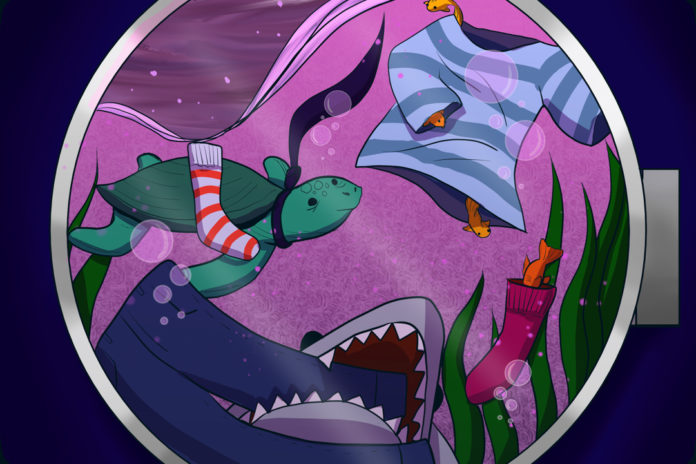Although we all recognize the importance of hygiene and self-care, we often do not think about how our hygiene habits could have a negative impact on the environment. Like many of us, you probably have some sort of laundry routine. Even if that routine consists only of throwing on a cycle when you run out of clean underwear or when your bath towels start to smell a little funky (we’ve all been there), it is a mundane chore that has to be done.
But as boring of a task as it is, it is important to recognize its tie to our water systems and ocean health. It goes beyond just being concerned about conserving water (although important); machine washing your clothes contributes to large quantities of water contamination and environmental pollution.
When you think about water pollution, you may think of the large pieces of plastic commonly seen floating in open water. Plastic bottles, plastic bags, tarps, and toothbrushes are all examples of large macro pollutants that contaminate our oceans. But have you ever thought about the smaller units of plastic that are not as easily visible? Microplastics are essentially tiny specks of plastic floating around in our waters. They can be as miniscule as the tip of a pencil, classified as less than 5 mm in diameter, yet pack a harmful environmental punch. In fact, there are an estimated 51 trillion pieces of microplastic in our oceans, and microplastics make up about 94 per cent of the Great Pacific Garbage Patch.
Microplastics can come from large macro plastics that begin to break down over time, or they get flushed into our water when we wash materials that contain synthetic fibres. Common synthetic fibres such as nylon, polyester, and spandex are types of microplastic that get released from our clothing when machine washed. A combination of detergents and the mechanical movement of a wash cycle allows fibres to loosen and release into the water. Moreover, due to their microscopic size, they can sneak through conventional filtration systems and leach into our oceans.
A major concern of microplastics is the effect on marine life. Due to their small size, they are not only a pollutant of our ecosystems, but they are also easily consumed by marine life. Many of these plastics can host harmful bacteria and toxic compounds that contaminate the animals and put them at risk. It is possible that these compounds can leach into the digestive systems and be stored in animal tissue. Not only is this bad for the marine life itself, but for those who choose to eat seafood, you are essentially indirectly consuming these hazardous compounds. In other words, you are a part of a food chain that is contaminated by microplastics.
Now, you might be asking yourself: is it all bad news? Are we just destined to choose between having clean clothes and protecting our oceans? Personally, I don’t think so, as there are some active steps you can take to decrease your contribution to microplastic contamination.
Purchase natural material clothing when possible: Compared to synthetic fibres, fibres derived from natural sources such as organic cotton or wool organically break down over time — unlike microplastics. The fast fashion industry heavily relies on synthetic materials, so try thrifting or purchasing from companies focused on sustainable material sourcing.
Try washing your clothes in cold water: This is such an easy thing to incorporate into your routine and has a large environmental impact. Studies suggest that washing clothes in cold cycles dramatically reduces the amount of microfibres released from material as well as preserves the longevity of your clothes.
Put your clothes in a garment bag: There are speciality bags that serve as an extra filter for your clothing when you decide to throw them in the wash. All you need to do is put your clothes in the garment bag, and then wash as usual. In doing so, you can catch some of those pesky microfibres that inevitably release into the water.
Don’t wash your clothes as often: I know this seems obvious, but hey, I had to mention it. If you only wore your shirt for a few hours or you sat at your desk all day and your pants are still clean, don’t wash them right away.
We know that plastic pollution is a major global issue. But the emphasis is typically on macroplastics, like water bottles and plastic bags, that contaminate our oceans and harm marine life. I think that microplastics are even more hazardous and changes need to be made. There are actions that us as individuals can take to decrease the amount of microplastics present in our water systems and oceans. Sometimes even the smallest of things, like changing up your laundry routine, can make the biggest difference for our planet.
Image: Danyka Van Santen/The Cascade
Sydney is a BA English major, creative writing student, who has been a content contributor for The Cascade and is now the Opinion editor. In 7th grade, she won $100 in a writing contest but hasn’t made an earning from writing since. In the meantime, she is hoping that her half-written novels will write themselves, be published, and help pay the bills.


